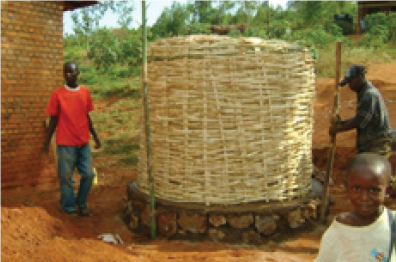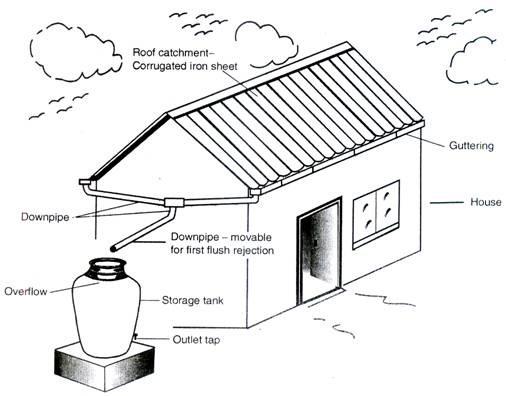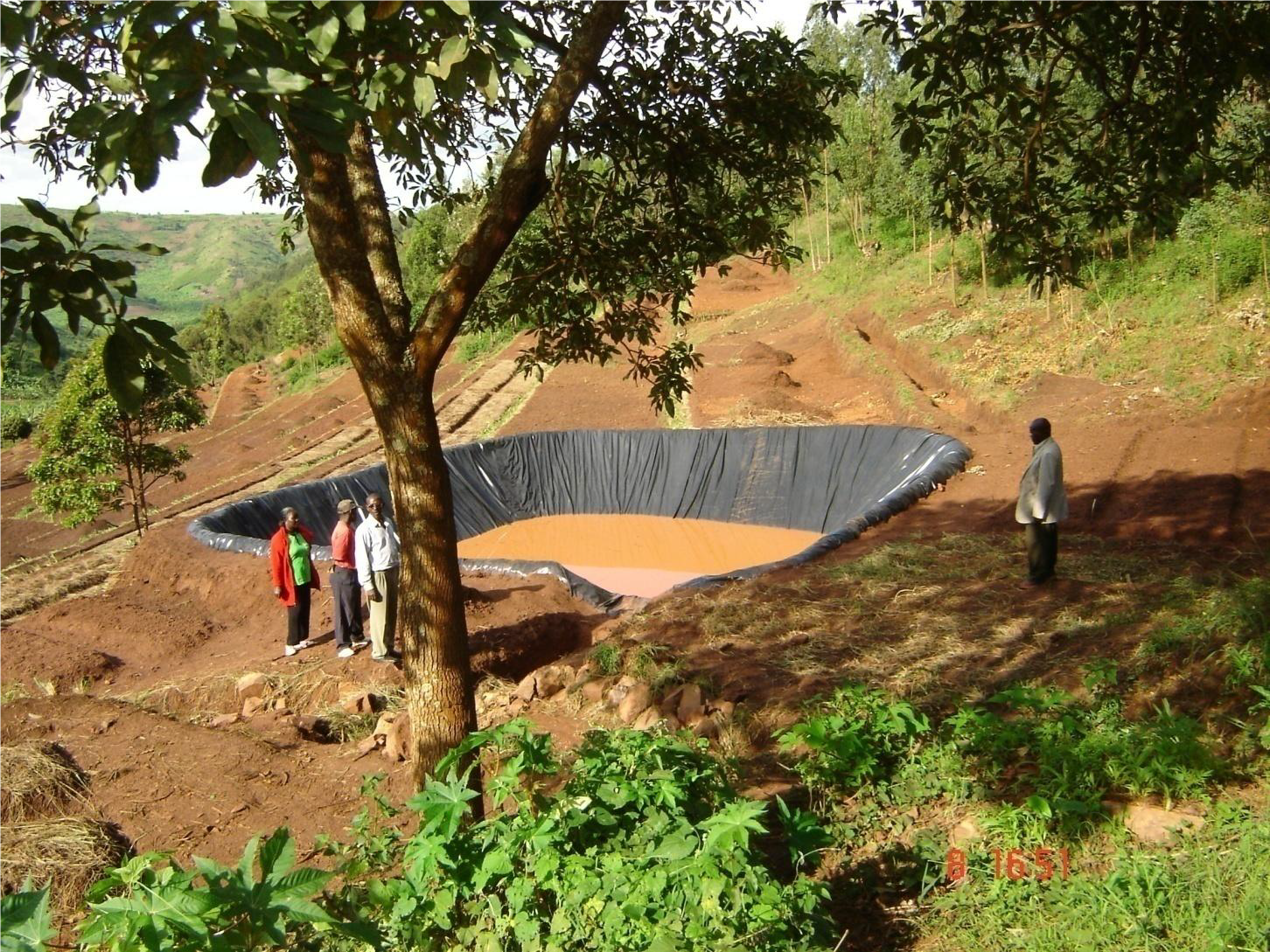Rainwater Harvesting
During the rainy season, large part of the rainfall is lost as runoff without being used by plants, animals or other human activity. The runoff causes erosion of fertile soils and eventually causes flooding downstream. Rain Water Harvesting (RWH) is a simple effective technology to increase resilience to droughts. It keep the rainfall closer to where it falls and store it for any use afterwards reducing runoff and risk of flooding.
The great adantage of RWH is that the technologies are simple and small scale. The operation and use is at level of household or few families which allows swift action. A farmer can use the water in the pond whenever needed and for whatever crop. This is not the case for larger systems that require an high level of organization, aligned cropping patterns and often joint commercial arrangement that take years to establish.
The Government of Rwanda promotes the adoption of rainwater harvesting as one key outputs under the Water Resources Management policy. A Rain Water Harvesting Strategy has been developed. RWH from rooftops is already widely practiced in schools, institutions and homes in Rwanda.
Rainwater can be harvested from:
- Fields, by increasing infiltration and increasing water holding capacity of the soil (terracing, soil improvement, filtration trenches, cut off drains and vegetation strips )
- Roofs of houses, schools, health centers churches
- Roads and other hard surfaces like school yards, urban areas.
- Hillside runoff
- Small streams

Rainwater can be stored in soils and storage in tanks, farm ponds valley dams and groundwater.
Trocaire has succesfully implemented low-cost water tanks. Bamboo is used instead of the iron bars in ferro-cement tanks.
A special form of rainwater harvesting is the tradition of spate irrigation. Storm flow from a gully, a stream or road is diverted and spread over agricultural field with or without crops. Large volumes of water are applied in a semi controlled way in short period. Infiltration of the water on the fields is increased by bunds and terracing. The water is stored in the soil profile and can be used by crops. Spate irrigation requires special skills to avoid damaging the crops and fields. In Rwanda it is practiced on a very small scale in a informal manner.
Rooftop rainwater harvesting
Rainwater harvested from rooftops is usually stored in tanks (1-6 m3) of plastic or ferrocement above the ground. Rainwater is basically clean but collects dirt from the surface and gutter and needs treatment before human consumption. The rainwater can be perfectly used for other domestic purposes like cleaning, washing, gardening, small animals and industrial use.

Runoff ponds
Runoff from roads or hillsides and small streams is stored in runoff and valley dams. Ponds and valley dams contain larger volumes of water than the rooftop harvesting tanks. The stored water is used for irrigation and cattle rearing. Private ponds in Rwanda have volumes of 120 m3 and collective ponds are build to 480 m3 (1 cubic meter is 1000 lts). In other countries farm ponds have storage capacities up to few thousand cubic meters. There are cases of systems of connected ponds that are fed by (ephemeral) streams.
Water from the farm ponds is used for a irrigated area that varies from 1000 to 5000 m2. Most farmers use it for supplementary irrigation of vegetables. The crops will benefit from the rain in march. The pond is used in a dry week interval or to finish the production when the rainy season has stopped. With appropriate seeds, fertilization and crop management high production levels can be achieved. 30.000 kg per hectare for tomatoes is no exception. The high value horticultural crops provide a welcome addition to the family income an contribute to the diet. Irrigated area and the pond itself are often protected by a fence.
The ponds dug in the sandy hillsides needs lining to avoid water loss through seepage. Special plastic dam sheets made for the dam size are imported from Kenya. These sheets need to be handled with care to avoid damage and water loss through the hoes. The ponds have a pipe at the bottom to release the water for irrigation. Where that is not possible a treadle pump is used to pump the water out.
MINIRENA through the Rwanda Agricultural Board (RAB) dug hundreds of ponds. The cost of the damsheet is RWF 400.000,- .is paid by the programe. The farmer has the obligation to dig the pond and install a fence around the pond. Fences keeps the cattle out and is important to protect against children who might fall in the pond. Organizations as Trocaire have experience with design and implementation of low-cost RWH tanks and farm ponds. They work through Community Based Organizations rooted in the local communities. Companies like ASWANET also offer installation of RWH systems.

Use of farm ponds
A pond on a small farm can be used for ducks, geese and fish. Plant and animal wastes fertilise the pond and/or feed the fish, sludge from the pond fertilises the croplands to raise more plants and animal-feed.
And ponds are often a viable land-use for marginal land or poor land. Even a small pond of 10 cubic meter in a backyard can be used for fish and improve the diet.
Valley dams
Valley dams are low (mostly less than 2 mts height) compacted earth bunds across the valley. The valley dams temporarily store water and often dry out towards the end of the dry season. These dams or pans are mostly used for watering livestock. The valley dam stops the rainwater runoff and creates a shallow lake behind the dam. The water infiltrates in the soil profile and feeds the groundwater. In some case replenishing the groundwater might be the main reason for the construction of the dam. The groundwater can feed the water sources downhill or can be pumped from the groundwater reservoir when needed.
FURTHER READING:
MINIRENA RWH strategy (pending approval)
MINIRENA-RWFA Loan and subsidy rainwater harvesting
REMA Guidelines for rainwater harvesting
Trocaire Manual for low-cost rainwater harvesting techniques
Trocaire ppt runoff ponds
Recharge, Retention and Reuse 3R Website
Introduction Rainwater harvesting in run off ponds
Dam sheets for Lining of ponds
Ntarama sector Evaluaton farmponds
Rainfoundation Manual on RWH
AKVOPEDIA Water portal Rainwater Harvesting
Rainfoundation Scaling up farm ponds
FAO guideline Farm ponds for water, fish, and livelihoods
Pond aquaponics New pathways to sustainable integrated aquaculture and agriculture
Various guidelines on fish farming and other uses of small ponds FAO and other sources: Aquaculture for small farms
SNV Netherlands Development Organization Sustainable pond farming
